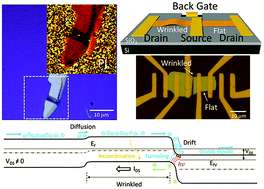Strain in a single wrinkle on an MoS2 flake for in-plane realignment of band structure for enhanced photo-response†
Abstract
Since 2D transition metal dichalcogenides (TMDs) exhibit strain-tunable bandgaps, locally confining strain can allow lateral manipulation of their band structure, in-plane carrier transport and optical transitions. Herein, we show that a single wrinkle (width = 10 nm–10 μm) on an MoS2 flake can induce confined uniaxial strain to reduce the local bandgap (40–60 meV per % deformation), producing a microscopic exciton funnel with an enhancement in photocurrent over flat MoS2 devices. This study also shows that wrinkles can spatially reconfigure the distribution of dopants and enhance the light absorption in the MoS2 layer via Fabry–Perot interference in its nanocavity. In the field-effect transistor studies on the MoS2 flat–wrinkle-flat device-structure, a higher carrier mobility and an improvement in the on/off ratio were exhibited in the devices with a single wrinkle. This phenomenon is attributed to the built-in potential induced by the bandgap reduction at the wrinkle site and the change in doping of the suspended wrinkle. The wrinkle-induced tunability of the local bandgap and manipulation of the spatial transport barriers, and the enhanced light absorption can enable development of next-generation electronic and optoelectronic devices guided by in-plane deformation of 2D nanomaterials.



 Please wait while we load your content...
Please wait while we load your content...
